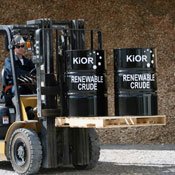The economy was not Mississippi's strong point this year, although the state is expecting to see job creation in the future. Several industries and businesses Gov. Haley Barbour touted as a successful this year require a healthy dose of government or public aid to open in Mississippi.
In September, Houston-based fuel developer KiOR announced plans to break ground with three new fuel processing plants that will create a petroleum substitute. The company claims that by 2015, the new plants "will deliver more than 1,000 direct and indirect jobs and an estimated $500 million worth of investment." Those facilities aren't likely to happen without a $75 million loan from the state of Mississippi and a purchase agreement with a refining company, which had not been secured as of September.
KiOR officials could not be reached by phone today for an update on where the proposed development stands.
An experimental $2.88 billion coal-burning power plant in Kemper County is expected to produce 260 new permanent jobs, at cost of about $10 million per job. The plants' construction is expected to provide up to 1,000 temporary jobs, the Mississippi Development Authority reports.
The plant will recoup its $2.88 billion investment from Mississippi Power Company rate payers , however--a considerable point of contention with many critics, including passionately opposed Mississippi Public Service Commissioner Brandon Presley.
The company broke ground in Kemper County on the construction of the new coal plant Dec. 16. The state aided the plant by providing it with GO Zone bonds and tax incentives.
Toyota recently completed construction of its $1 billion automotive manufactoring plant near Tupelo, after the project stalled in 2008 when the economy collapsed.
The company plans to produce 140,000 vehicles a year when it opens in 2011, and employ up to 2,000 individuals, a feat the state legislature and Barbour aided with $300 million in incentives. The state has also promised the company a 20-year corporate-tax holiday. In 2007, Toyota announced that the plant would produce Toyota's once-popular Highlander. It will now produce the less-expensive Corolla. The new jobs will only provide an economic boost if the majority of workers live in Mississippi, instead of crossing the state line from neighboring states like Alabama or Tennessee and spending their paychecks at home.
Some old businesses are on the way out, particularly in manufacturing. One example is Great American Wirebound Box, a company that employs 50 in Fernwood is closing its doors after 100 years of operation this month. Land O' Lakes Purina Feed plant in Lumberton also closed, leaving 18 people without jobs.
The state's workers fared badly this year. Mississippi Institutions of Higher Learning data finds that 100,000 Mississippi residents are unemployed at the end of this year, and the state maintained an average 10 percent average unemployment rate in 2010, with 17 percent unemployment levels for African Americans.
The unemployment rate is expected to remain about the same in 2011.
Retail sales increased in the first half of 2010, but then dipped in July and August, increasing again in September and during the holidays. State sales-tax collections were 7.2 percent below estimates in 2010, and school districts across the state employed 4,500 fewer people in September 2010 than it did that same month in 2009.
Mississippi has depleted much of its federal stimulus money, which helped stave off many lay-offs over the last two years, according to IHL. The state reported in November that it spent nearly $1.8 billion of the $2.7 billion the federal government gave it to battle the recession.



Comments
Use the comment form below to begin a discussion about this content.
comments powered by Disqus